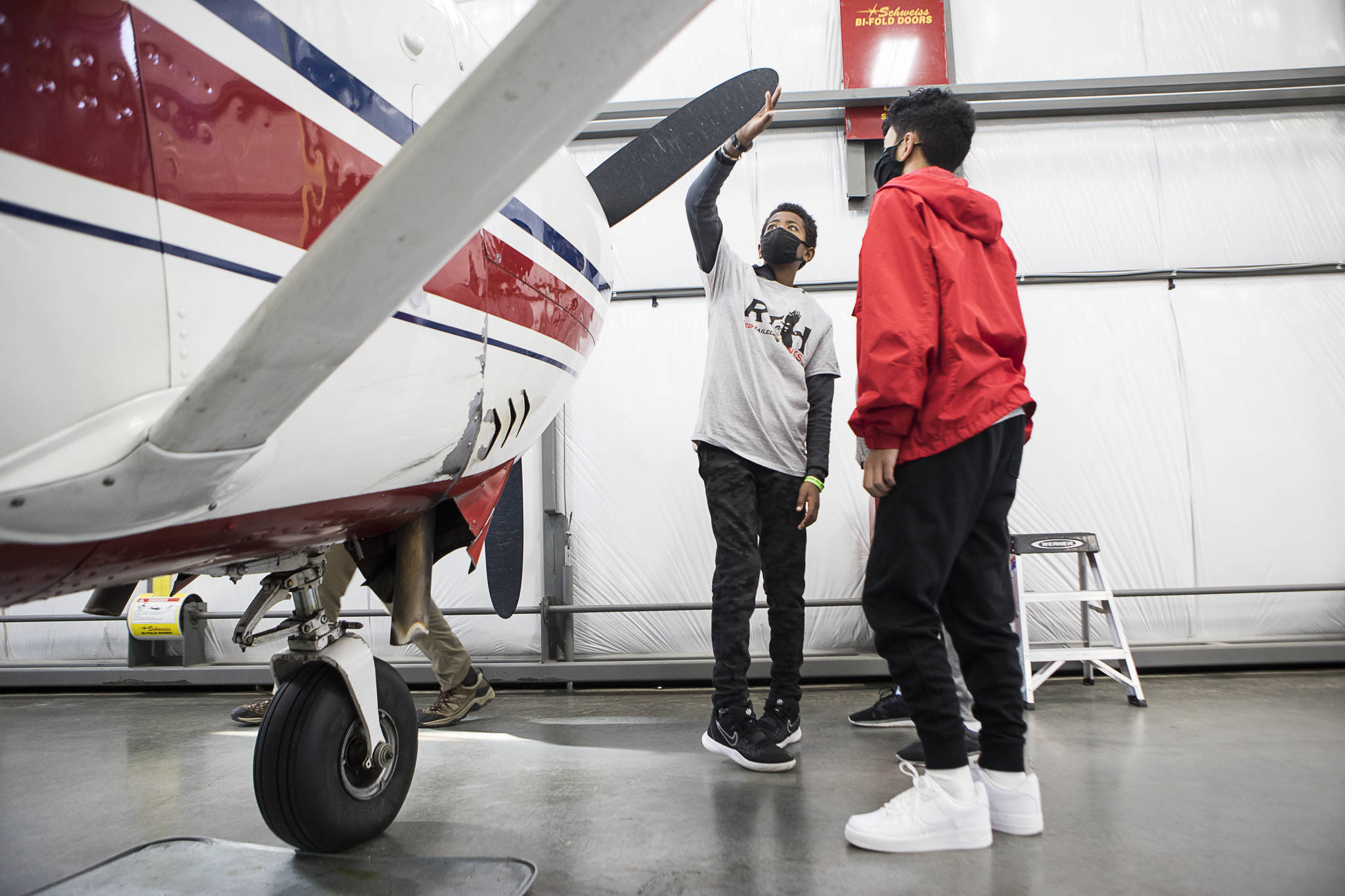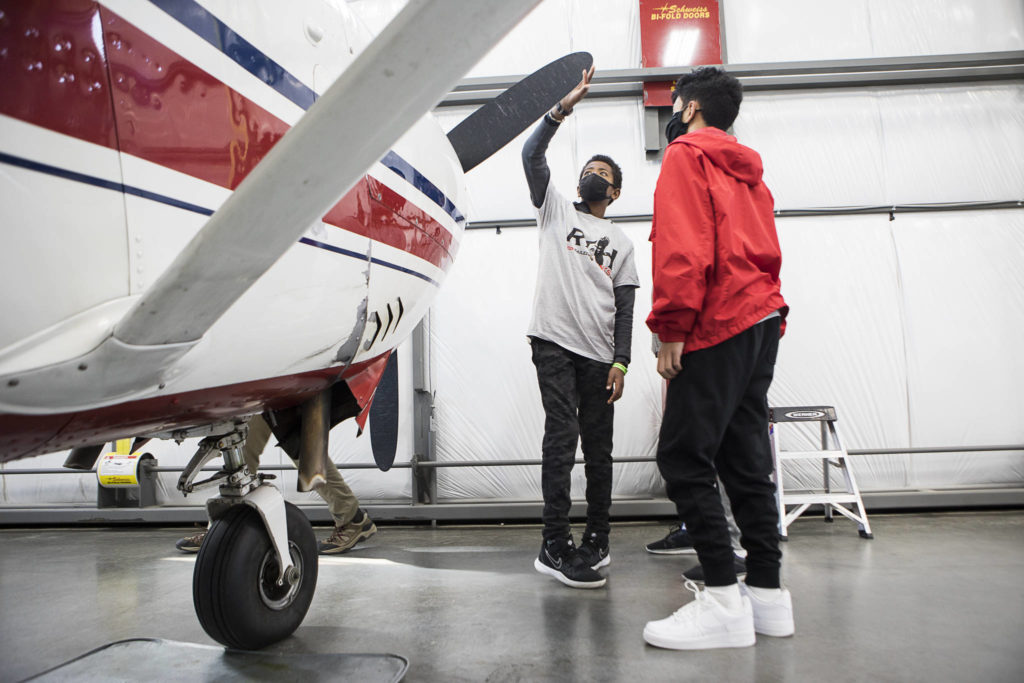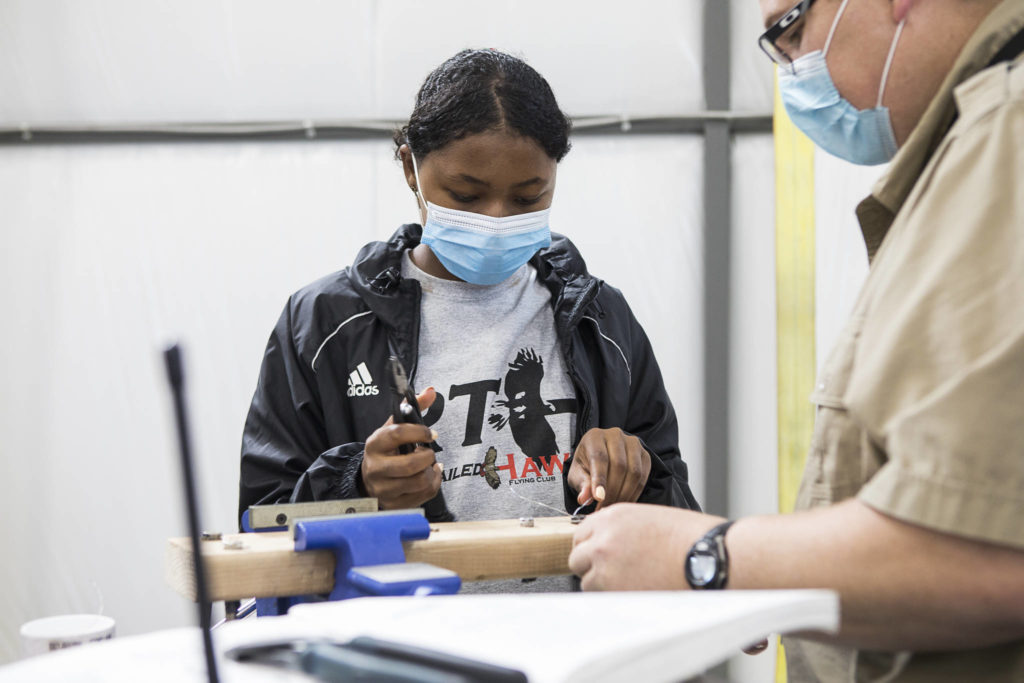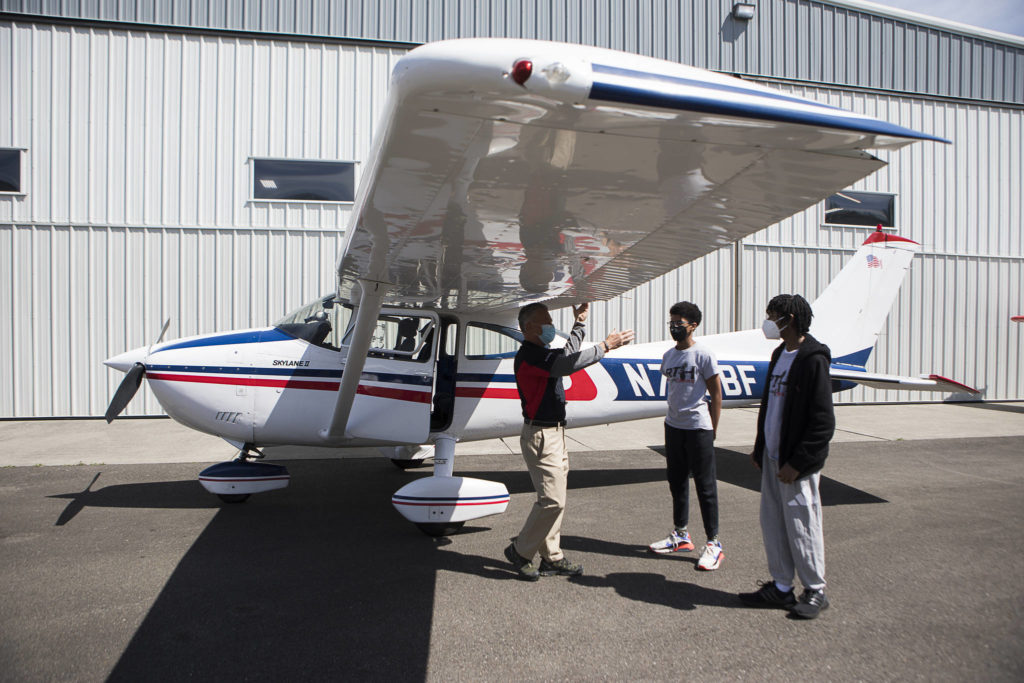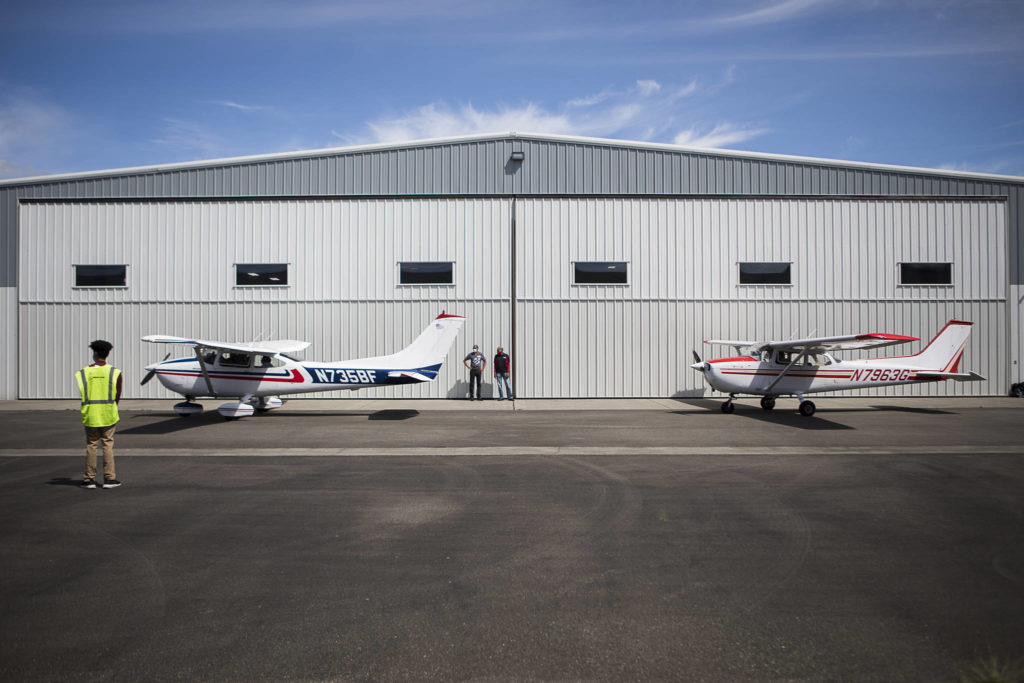MUKILTEO — For as long as he can remember, Spencer Brashears wanted to be a pilot. As a toddler, he pointed to airplanes in the sky. One of his first books? An encyclopedia of aircraft. “I was barely talking, but I could tell you every make and model of every airliner and every military plane,” said Brashears, who grew up in Seattle.
Now a flight instructor in Raleigh, North Carolina, Brashears recently began pilot training with an airline.
But his journey to the cockpit hasn’t always been smooth.
“Even now, I still meet people who’ll say, ‘You’re a pilot? I didn’t know Black people can do that,’” said Brashears, who is African American.
Until World War II, Blacks weren’t allowed to serve as pilots in the military. It took another 20 years and a U.S. Supreme Court ruling in 1963 for Marlon Green, a former Air Force pilot, to pave the way for the first Black pilot to be hired by a major commercial airline.
Today, just 3.4% of commercial pilots in the U.S. are Black, according to the U.S. Bureau of Labor Statistics.
A Snohomish County group hopes to increase the percentage.
The Red-Tailed Hawks Flying Club, based in Mukilteo, introduces underserved youth — Blacks, women and people of color — to aviation, science and aerospace careers.
“Right now, Blacks are under-represented in aviation. Women are under-represented,” said Jesse D. Hayes IV, an Air Force veteran and Boeing engineer who founded the club in 2013 as a way to reach a broader group of kids.
It encouraged Brashears, 26, one of the club’s first members, to pursue his passion.
The Red-Tailed Hawks is chartered by the Black Pilots of America. In 1968, Hayes’ father helped found a sister group, the Bronze Eagles Flying Club of Texas. “I grew up around pilots and so now I’m continuing the legacy,” Hayes said.
The club takes its name from the raptor but also alludes to the Tuskegee Airmen, a group of Black U.S. military pilots that fought in World War II. The P-51 Mustang fighter aircraft they flew during combat missions were distinguished by the red markings on the tails, earning them the “Red Tails” nickname. In a racially fraught era, the highly decorated Tuskegee Airmen earned the praise of fellow service members and military leaders.
The club’s youth program targets sixth- through 12th-graders. “Our goal is to grab them in middle school and hold onto them for life,” Hayes said. Hayes and a network of some 50 adults, including commercial pilots and engineers, promote the club at schools, churches and youth groups.
Today, some of its first members are making their mark.
“Our first girl got her private pilot’s license in 2017 and graduated from Embry-Riddle Aeronautical University with an aerospace degree. Our first boy is flying for Republic Airways,” Hayes said proudly.
The coming shortage
The aerospace industry is facing a shortage of pilots, aircraft mechanics and engineers. Although the COVID-19 pandemic caused a severe downturn throughout the aviation industry, air travel is now on the upswing and demand for skilled workers is also rising. Some experts contend the coming shortage will be even more acute because many pilots took early retirement at the request of their employers during the pandemic.
Airlines and airplane makers are stepping up recruitment efforts with an enhanced emphasis on diversity.
Alaska Airlines, Delta Air Lines, Southwest Airlines and other commercial carriers have pledged to diversity their workforce, including at the highest levels of leadership. United Airlines, which recently established its own flight academy, laid out an ambitious plan to train 5,000 new pilots by 2030, at least half of them women and people of color.
Last summer, the Boeing Co. said it would raise the number of Black employees by 20% and establish a Racial Equity Task Force.
The Red-Tailed Hawks aims to help fill the gap.
“We started with two kids and now we have over 80 active youth members,” Hayes said. “This is to help the industry look more like the world we live in.”
Like Brashears, Dillon Stidwell, 14, began plane spotting when he was a toddler.
“I was in a daycare near Paine Field and I’d stare out the window to watch the planes,” Stidwell said. Now the Everett resident hopes to earn his private pilot’s license and eventually fly for an airline. “This group has put me on the right track,” Stidwell said.
London Holmes, 19, a Seattle resident, was introduced to the club a few years ago by Kim Ford, a Black pilot at Seattle-based Alaska Airlines. Holmes is now a freshman at the Air Force Academy in Colorado Springs.
“It was really cool being around people my own age who were interested in the same thing as me,” Holmes said. “I was surrounded by pilots who look like me. You don’t see that a lot.”
Two new airplanes
The Red-Tailed Hawks recently achieved a new milestone and bought two Cessna 172 single-engine airplanes.
When not in use by the club, the two airplanes will be leased to a flight school at Boeing Field, generating income for the group.
“This expands our flight training capacity,” Hayes said of the purchase, which was made possible by “a generous community of donors.”
Bella Capuano, 20, who joined the group when she was 15, helped ferry one of the two planes from McMinnville, Tennessee, to Boeing Field in Seattle.
An aviation fan since she was a seventh-grader, the club helped Capuano set her sights on the flight deck.
“I always thought I would be on the engineering side and work for Boeing,” said Capuano, who earned her pilot’s license while still in high school. A club-sponsored visit to Southwest Airlines’ Dallas headquarters turned her head. When she tried out the airline’s flight simulators, she was hooked. Now Capuano is a student at Baylor University in Waco, Texas, and hopes to be an airline pilot for “Southwest or American,” she said.
The Red-Tailed Hawks draws students from across the Northwest. Members attend weekly virtual meetings where pilot knowledge, aviation history and math and science are part of the curriculum.
“Academics are a big part of the club,” Hayes said. Students who want to join must submit an aviation-related essay, he said.
“First-time visitors are always welcome,” Hayes said. “If they come twice they’ve got to become a member.”
Once a month the club visits flight schools, museums and airports. Seattle-Tacoma International Airport, Boeing, Microsoft and Blue Origin, the Kent space company, and Seattle’s Museum of Flight are popular destinations. Students are also given the opportunity to fly with experienced pilots, Hayes said.
“We give them airplane rides,” said Hayes. “If they like it, we’re more than happy to invest thousands of dollars in them, but they have to show they’re serious about learning.”
‘Their eyes light up’
Club members recently visited the Mission Aviation Training Academy at Arlington Municipal Airport. The group trains Christian missionary pilots.
Instructors offered lessons in pre-flight checks, installing rivets and attaching safety wire.
Erin Howard, 15, tried her hand at attaching a length of steel wire to a pair of bolts with a special pliers that twists the wire.
When properly set, the wire is used to secure airplane components, preventing them from being loosened by the normal vibrations of flight.
Giving the wire the proper spin takes a lot of practice, said Dary Finck, the academy’s executive director. “It’s one of those things you can mess up if you don’t pay attention to details,” Finck said. “As missionary pilots, we have to be able to maintain our own aircraft in remote locations.”
Howard, a Seattle resident, found the Red-Tailed Hawks through a friend and joined this year.
“My grandfather inspired me to become a pilot,” Howard said. “He was in the Air Force with Chuck Yeager,” who was the first aviator to break the sound barrier in 1947. “When he was a pilot, no one was there to welcome him after a flight. The Red-Tailed Hawks is here to take care of that.”
Joe Hopkins, a ground-school instructor at the academy, demonstrated how to conduct a pre-flight check.
“Check for dents in the wings. Check the hinge bolt. Make sure there’s no bugs clogging the pitot tubes,” Hopkins told students. (Pitot tubes measure air pressure and velocity.)
Watching in the wings, Samantha Carter, 21, knows the drill by heart. At 18, she earned her private pilot’s license with a financial assist from the Red-Tailed Hawks. The Seattle resident graduated this year from Embry-Riddle Aeronautical University in Prescott, Arizona, with a degree in aerospace engineering. In the fall, she heads to Maryland to become part of a flight test team for the U.S. Navy.
A club member since 2014, Carter was also inspired by a doting grandfather.
“In my freshman year of high school, I mentioned to him that I wanted to be a pilot,” Carter said. The next day he showed up with “a pile of books” and introduced her to the Red-Tailed Hawks, she said.
The club has helped change lives, Carter said.
“Some of the kids came from a background where they didn’t have both parents or wouldn’t be as interested in STEM if they weren’t in the club,” Carter said. “When I was there, we had people of different backgrounds. They accept everyone.”
Brashears, training to be a commercial airline pilot, visits the club as often as he can in hopes of giving kids a glimpse of what’s possible.
“All that’s pushed on Black kids is sports and entertainment,” Brashears said. “They’ve never seen somebody that can be an aeronautical engineer or an airline pilot. When I show kids pictures or videos of me flying, I see their eyes light up like, ‘Wow, this is really real.’”
Janice Podsada; jpodsada@heraldnet.com; 425-339-3097; Twitter: JanicePods
Talk to us
> Give us your news tips.
> Send us a letter to the editor.
> More Herald contact information.
